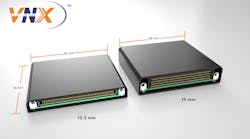VNX+ and small-form-factor SOSA: the next trend in embedded computing
This article appeared in Military+Aerospace Electronics and has been published here with permission.
THE MIL & AERO BLOG – The next generation of open-systems small-form-factor embedded computing is nearly ready for industry, and is likely to become part of the upcoming Sensor Open Systems Architecture (SOSA) 2.0 industry standard that should see ratification later this year or early next.
It's called VNX-plus -- written as VNX+. Its computer modules should be about the size of a deck of playing cards, and will be a downscaled version of 3U VPX embedded computing boards and backplanes, which are described in standards of the VITA Open Standards, Open Markets trade association in Oklahoma City.
The small size of VNX+ will fit into a five-inch tube to accommodate small-yet-powerful applications, including 100-millimeter cubesats, stealthy unmanned underwater vehicles (UUVs), and artillery-launched sensors for long-term monitoring of contested areas.
Advocates say the conduction-cooled VNX+ will have the look and feel of 3U VPX, but will be substantially smaller, and will help ease the transition to small-form-factor embedded computing systems. The goals of VPX+ are to reduce embedded computing size, weight, and power consumption (SWaP), systems costs, and time to market for small-form-factor embedded computing.
It's most promising applications include small unmanned aerial vehicles (UAVs), aircraft weapons pods, small satellites called cubesats, and future generations of smart munitions. Essentially the emerging standard is to enable industry-standard designs that used to require custom approaches, says Bill Ripley, an industry consultant for embedded computing specialist Samtec USA in New Albany, Ind., and a longtime pioneer and advocate of small-form-factor embedded computing.
VNX+ is a logical evolution of an earlier small-form-factor embedded computing standard called VNX, or ANSI/VITA 74, which was ratified by the American National Standards Institute (ANSI) in Washington back in 2017. VNX+ is intended to succeed where similarly sized VNX fell short. "There wasn't a driving need for VITA 74; it was ahead of it time," Ripley explains.
First and perhaps most importantly, VNX+ can handle far more power than VITA 74 ever could. VNX+ expands thermal performance to 80 Watts, where VNX could handle only 20 Watts. Plus, VNX+ is optimized for signal integrity at high speeds, where VITA 74 came on the scene before the speeds of today's high-speed switch fabrics even were envisioned. Plus the new standard is designed to accommodate today's fast databuses and switch fabrics.
The concept of VNX+ has worked, and "interest in VITA 90 has been overwhelming," Ripley says.
VNX+ also is being designed for to accommodate aerospace and defense applications today and in the future, with related standards in the works. The future VITA 90.4 is being designed to accommodate wedge locks for designers who need them, and VITA 90.5 is being designed for space applications.
VITA 90.5 will emulate many characteristics of the ANSI/VITA 78 SpaceVPX systems standard, which offers high performance, fault tolerance, and interoperable backplanes and modules for high-availability orbital space applications -- like cubesats.
Like 3U VPX, the upcoming VNX+ standard will capitalize on OpenVPX standards, and take advantage of the commercial infrastructure that supports these standards.

